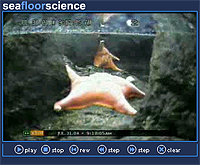Speeding-Up Time
Time-lapse photography
Time-lapse photography

Can you guess how much actual time elapsed in each movie? See the bat stars go!
Photo from the Ocean Institute
All that you can do at OI
In order to study the behavior of animals that move so slowly, scientists need to watch them over long periods of time, but the intertidal zone is not a convenient place to sit for long. The tide is only out for a little while, if at all, each day. And even the most patient person in the world might have a hard time watching and paying attention for so long.
Fortunately, scientists have developed more convenient digital imaging technologies that allow them to record life in the intertidal zone over periods of hour, days, and even weeks. Instead of standing out in the tide pool, they can leave a very patient camera to watch for them.
Instead of recording all the time, time-lapse systems take pictures at intervals -- every 10 seconds or once a day, for example. Strung together, these still pages make up a moving picture like images in a flip-book or movie film. A whole day's observations can then be viewed in a few minutes, at faster than real-time speeds.
One problem with trying to watch plants and animals over long periods of time is that action takes place in the dark. After all, it's night nearly half of a day and many living things are active at night. Other living things might just live in dark places, like under rocks.
In both cases, lights might be good for filming, but visible light would disturb natural activities at the tidepool. So how do researchers get a glimpse of what goes on under undisturbed circumstances? They have another tool that allows them to see in the dark: Infrared Cameras.
Where to find more information:
Bat Star (Asterina miniata)
Ocean Institute
Knobby Sea Star (Pisaster giganteus)
Ocean Institute
Plants-In-Motion
Other uses of time-lapse photography. See time-lapse movies of plants.
Roger P. Hangarter, Indiana University
Time-Lapse Movies of Crab Nebula
Other uses of time-lapse photography. See time-lapse movies of outer space.
Chandra X-ray Observatory
Santa Catalina Mountain Cloud Project
Other uses of time-lapse photography. See time-lapse movies of outer space.
Partnership for Research in Spatial Modeling, Arizona State University
Produced in collaboration with Scripps Institution of Oceanography.
Website by Earthguide.
© 2003-2004 by the Ocean Institute
and the Regents of the University of California.
All rights reserved.
Last modifed Monday, December 10, 2004
